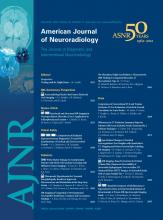We read with great interest the article by Kranz et al in the August 2012 issue of AJNR entitled, “CT Fluoroscopy-Guided Cervical Interlaminar Steroid Injections: Safety, Technique, and Radiation Dose Parameters.”1 The authors concluded that CT fluoroscopy (CTF)– guided epidural steroid injections (ESIs) can be performed with a low rate of procedural complications and short procedural and CTF times, making these a practical alternative to using conventional fluoroscopy (CF).
While we agree that CTF provides superior visualization of anatomic structures in relation to the needle tip compared with CF, we do not believe that such precise visualization is necessary or increases the safety of the procedure. Our group of 3 neurointerventionalists has performed hundreds of interlaminar cervical ESIs by using CF for years without a single clinical complication.
We use single-plane CF (Inova 4100IQ; GE Healthcare, Milwaukee, Wisconsin), starting with a near-anteroposterior tube position until the needle is advanced to touch the spinal lamina, at which time the tube is rotated steeply in the contralateral oblique position to permit live CF visualization of needle advancement to the spinolaminar line. A loss-of-resistance technique is then used to advance the needle tip into the epidural space, which is confirmed with injection of 1 mL of contrast. Inadvertent subarachnoid injection is rare but is easily identified by rapid dissipation of contrast from the needle tip and pooling in the dependent subarachnoid space.
A review of our last 16 cases revealed a mean CF time of 0.9 minutes, procedural time of 10 minutes, and mean entrance skin air kerma (ESAK) of 16.7 mGy. If one assumes a mean shaded surface display of 64 cm, skin exposed area of 49 cm2, beam quality of 4.3 mmAl, mean kilovolt (peak) of 70, and effective dose per milligray of ESAK to be 0.015–0.03 mSv/mGy (depending on tube angulation), the effective dose was 0.3 mSv, and the skin dose, 23 mGy. By comparison, by using the authors' parameters of mean CTF time = 24 seconds with a median tube current of 70 mA and assuming a 1-cm CTF scan range, the effective dose would be approximately 2.1 mSv, depending on scan position. Moreover, if one assumes a mean neck circumference of 38 cm, the approximate skin dose of a CTF procedure, excluding planning scans, is close to 0.5 Gy. These doses are already 7 and 20 times the CF effective and skin doses to the patient respectively, without accounting for CT planning scans. Higher doses to the operator with CTF can also be expected and should be monitored.2
The authors stated that many operators using CF inject at the C7-T1 interspace or below where the spinal canal is wider, to increase safety, and that this location limits the amount of medication reaching stenotic levels more cranially. We disagree that this is a significant limitation due to the small volume and relatively short length of the cervical epidural space. We typically observe contrast migration for several spinal levels with just 1 mL of contrast injection. A nuclear medicine study revealed impressive cranially directed spread of technetium Tc99m-labeled red blood cells from the site of the epidural injection.3 Regardless, we also perform CF-guided cervical ESIs from C2–3 to C7-T1, unless MR imaging shows such severe spinal stenosis that the spinal cord directly abuts the ligamentum flavum; then, we target an adjacent level.
The authors describe waiting for 3–4 seconds after contrast injection before rescanning with CTF to detect washout in the event of vascular injection. We have observed cases of mixed injection into the epidural space and an epidural vein that would be missed by using this approach.
While we appreciate the authors' work and the proposition to use CTF as an alternative to CF for cervical interlaminar ESIs, we believe that they overestimate the safety of CTF, particularly with regard to radiation exposure. CF provides adequate visualization of pertinent anatomy and allows superior confirmation of needle-tip position during contrast injection. CF procedures can be completed in less time, with less expense and a lower radiation dose without compromising procedural safety.
References
- © 2012 by American Journal of Neuroradiology







